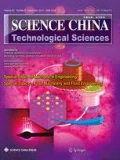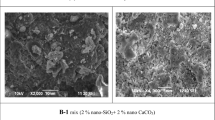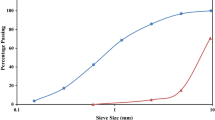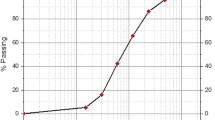Abstract
In the present study, abrasion resistance and compressive strength of concrete specimens containing SiO2 and CuO nanoparticles in different curing media have been investigated. Portland cement was partially replaced by up to 2.0 wt% of SiO2 and CuO nanoparticles and the mechanical properties of the produced specimens were measured. Increasing the nanoparticles content was found to increase the abrasion resistance of the specimens cured in water and saturated limewater, while this condition was not observed for compressive strength in the both curing media. The enhancement of abrasion resistance was higher for the specimens containing SiO2 nanoparticles in both curing media. Since abrasion resistance and compressive strength of the specimens followed a similar regime as the nanoparticles increased for the specimens cured in saturated limewater, some experimental relationships has been presented to correlate these two properties of concrete for this curing medium. On the whole, it has been concluded that the abrasion resistance of concrete does not only depend on the corresponding compressive strength.
Similar content being viewed by others
Change history
05 August 2022
A Correction to this paper has been published: https://doi.org/10.1007/s11431-022-2135-6
References
Naik T R, Singh S, Hossain M M. Abrasion resistance of concrete as influenced by inclusion of fly ash. Cement Concrete Res, 1994, 24(2): 303–312
Atis C D. High volume fly ash abrasion resistant concrete. J Mater Civil Eng, 2002, 14(3): 274–277
Naik T R, Singh S S, Hossain M M. Abrasion resistance of high strength concrete made with class C fly ash. ACI Mater J, 1995, 92(6): 649–659
Gjorv O E, Baerland T, Ronning H R. Abrasion resistance of high strength concrete pavements, Concrete Int, 1990, 12(1): 45–48
Atis C D. Abrasion-porosity-strength model for fly ash concrete. J Mater Civil Eng, 2003, 15(4): 408–410
Langan B W, Joshi R C, Ward M A. Strength and durability of concrete containing 50% Portland cement replacement by fly ash and other materials. Can J Civil Eng, 1990, 17: 19–27
Nanni A. Abrasion resistance of roller-compacted concrete. ACI Mater J, 1989, 86(53): 559–565
Bjornstrom J, Martinelli A, Matic A, et al. Accelerating effects of colloidal nano-silica for beneficial calcium-silicate-hydrate formation in cement. Chem Phys Lett, 2004, 392(1–3): 242–248
Ji T. Preliminary study on the water permeability and microstructure of concrete incorporating nano-SiO2. Cem Concr Res, 2005, 35(10): 1943–1947
Jo B W, Kim C H, Tae G H, et al. Characteristics of cement mortar with nano-SiO2 particles. Construct Build Mater, 2007, 21(6): 1351–1355
Li H, Xiao H G, Ou J P. A study on mechanical and pressure-sensitive properties of cement mortar with nanophase materials. Cem Concr Res, 2004, 34(3): 435–438
Li H, Zhang M H, Ou J P. Abrasion resistance of concrete containing nanoparticles for pavement. Wear, 2006, 260(11–12): 1262–1266
Qing Y, Zenan Z, Deyu K, et al. Influence of nano-SiO2 addition on properties of hardened cement paste as compared with silica fume. Construct Build Mater, 2007, 21(3): 539–545
Lin K L, Chang W C, Lin D F, et al. Effects of nano-SiO2 and different ash particle sizes on sludge ash-cement mortar. J Environ Manage, 2008, 88(4): 708–714
Lin D F, Lin K L, Chang W C, et al. Improvements of nano-SiO2 on sludge/fly ash mortar. Waste Manage, 2008, 28(6): 1081–1087
Sobolev K, Flores I, Torres-Martinez L M, et al. Engineering of SiO2 nanoparticles for optimal performance in nano cementbased materials. In: Bittnar Z, Bartos PJM, Nemecek J, et al., eds. Nanotechnology in Construction: Proceedings of the NICOM3 (3rd International Symposium on Nanotechnology in Construction), Prague, Czech Republic, 2009. 139–148
Qing Y, Zenan Z, Li S, et al. A comparative study on the pozzolanic activity between nano-SiO2 and silica fume. J Wuhan Univ Technol-Mater Sci Ed, 2008, 21(3): 153–157
Campillo I, Guerrero A, Dolado J S, et al. Improvement of initial mechanical strength by nanoalumina in belite cements. Mater Lett, 2007, 61: 1889–1892
Li Z, Wang H, He S, et al. Investigations on the preparation and mechanical properties of the nano-alumina reinforced cement composite. Mater Lett, 2006, 60: 356–359
Li H, Xiao H, Ou J. A study on mechanical and pressure-sensitive properties of cement mortar with nanophase materials. Cement Concrete Res, 2004, 34: 435–438
Flores-Velez L M, Dominguez O. Characterization and properties of Portland cement composites incorporating zinc-iron oxide nanoparticles. J Mater Sci, 2002, 37: 983–988
ASTM C150, Standard Specification for Portland Cement, Annual Book of ASTM standards. Philadelphia: ASTM, 2001
ASTM C39, Standard Test Method for Compressive Strength of Cylindrical Concrete Specimens. Philadelphia: ASTM, 2001
ASTM C1138, ASTM C1138-97 Standard Test Method for Abrasion Resistance of Concrete (Underwater Method). Philadelphia: ASTM, 2001
Hall C. Water sorptivity of mortars and concretes: A review. Mag Concr Res, 1989, 41(14): 51–61
Mostafa N Y, Brown P W. Heat of hydration of high reactive pozzolans in blended cements: Isothermal conduction calorimetry. Thermoch Acta, 2005, 435: 162–167
AI-Khalaf M N, Yousift H A. Use of rice husk ash in concrete. Int J Cem Compos Lightweight Concr, 1984, 6(4): 241–248
Jawed J, Skalny J, Young J F. Hydration of Portland Cement. Structure and Performance of Cements. Barnes P, ed. Essex: Applied Science Publishers, 1983. 284–285
Author information
Authors and Affiliations
Corresponding author
Additional information
This article has been retracted. Please see the retraction notice for more detail: https://doi.org/10.1007/s11431-022-2135-6
About this article
Cite this article
Riahi, S., Nazari, A. RETRACTED ARTICLE: Compressive strength and abrasion resistance of concrete containing SiO2 and CuO nanoparticles in different curing media. Sci. China Technol. Sci. 54, 2349–2357 (2011). https://doi.org/10.1007/s11431-011-4463-4
Received:
Accepted:
Published:
Issue Date:
DOI: https://doi.org/10.1007/s11431-011-4463-4




